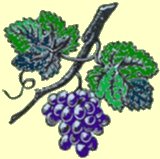Texas Cognac
Today, we grow grapes. The University of Houston's College of Engineering presents this series about the machines that make our civilization run, and the people whose ingenuity created them.
Many Americans, who were in favor of invading Iraq, swore off Cognac when France declined to join us. Well, Cognac turns out to be much less French than it seems. Our story begins in 1865, a decade before the French began building our Statue of Liberty.
French wine-makers were doing grafting experiments with American grapes. Some of those grapes carried a small creature called the phylloxera root louse. The Phylloxera louse, in turn, carried a devastating root disease. By the time Miss Liberty arrived, phylloxera had wiped out most of the vineyards in the Cognac region. The French tried every imaginable cure, including some pretty radical stuff -- like urinating on the vines and planting toads among their roots.
Grapes are normally grafted on to whatever root system works best; you don't grow them from seeds. So the solution to the phylloxera plague was to turn again to America for a rootstock with a natural immunity to the disease. But none of the rootstocks they found here could grow in the chalk-lime soil of Cognac.
Enter now a man named Thomas Munson. In 1870, Munson was the second person to graduate from a new land-grant college that would become the University of Kentucky. Munson's agricultural studies made a particularly powerful impression on him. It was that grapes were, and I quote,
the most beautiful, most wholesome and nutritious, most certain and most profitable fruit that could be grown.
 By 1877, after a French delegation had come here to find a rootstock that might survive in Cognac, Munson's search for the definitive grape had led him to Denison, in northern Texas. Denison proved to be a kind of grape heaven for Munson. The French had searched in vain for ten years, but Munson had begun publishing articles on his grape hybrids. When the French finally read his work, they steered their long pilgrimage toward Texas.
By 1877, after a French delegation had come here to find a rootstock that might survive in Cognac, Munson's search for the definitive grape had led him to Denison, in northern Texas. Denison proved to be a kind of grape heaven for Munson. The French had searched in vain for ten years, but Munson had begun publishing articles on his grape hybrids. When the French finally read his work, they steered their long pilgrimage toward Texas.
And they found their holy grail here. Munson took them to the limestone country of central Texas and showed them rootstocks that would like the soil of the Cognac region as well as being immune to the ravages of phylloxera lice. We were soon shipping thousands of bundles of rootstock to France where an enormous root-grafting program was begun.
So French cognac was saved. And, in 1888, Munson was awarded the Chevalier du Mérite Agricole -- named a knight of agricultural excellence. He was inducted into the Legion of Honor. And the French Remembered him: In 1992, the towns of Cognac and Denison officially joined to become sister cities.
All this warms my insides -- not the brandy, I don't even like the stuff -- but, rather, knowing that the terribly fancy European Cognacs are born upon a root grown in the middle of Texas. Underlying all this I find, in Thomas Munson, a fine exemplar.
This knight of the grapevine showed us what can happen when one person combines single-minded study with a conviction that he can change the world. I wish I could've known him.
I'm John Lienhard, at the University of Houston, where we're interested in the way inventive minds work.
(Theme music)
R. West, Root de France. Kentucky Alumnus. 1988, No. 4, pp. 14-16.
Here's an on line image of the phylloxera louse
This is a greatly revised version of Episode 214.
